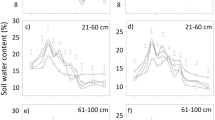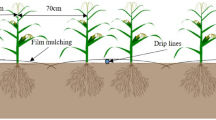Abstract
In the semi-humid region of northeast China, the plastic-film mulching (PFM) is essential for sustaining yields, while the yield-increase potential and nitrogen (N) use mechanism under different PFM patterns in this area remain poorly understood. A field experiment using maize (Zea mays L.) was conducted for two consecutive years to study the effects of different PFM patterns on soil microclimate factors, N mineralization, N loss, crop yields and N use efficiency under drip irrigation. The six treatments consisted of full ridge-furrow mulching (FM), only ridge mulching (RM), non-mulching (NM), ridge-furrow mulching without fertilization (CFM), ridge mulching without fertilization (CRM), and non-mulching without fertilization (CNM). The results showed that the PFM could obviously warm the soil throughout the growing season. Compared to NM, FM and RM obviously increased the soil temperature by 2.0–5.4 ℃ and 1.6–4.8 ℃ in the 2017 season, respectively, and by 1.9–7.8 ℃ and 1.0–5.7 ℃ in the 2018 season, respectively. Across two years, soil temperature was highest for FM followed by RM and NM. In general, FM enhanced the soil water content compared with RM, especially in the 0–50 cm profile throughout the growing season. The PFM could significantly (p < 0.05) promote soil N mineralization (Nmin). Furthermore, irrespective of fertilization, the PFM significantly (p < 0.05) improved plant N uptake (Nuptake), grain N accumulation (Ngrain) and N harvest index (NHI). Averaged across years, full ridge-furrow mulching and only ridge mulching distinctly enhanced the NHI under fertilization by 6.8% and 6.1%, respectively, relative to non-mulching. Finally, PFM imposed significant influence (p < 0.05) on ear barren tip, 100-seed weight and grain yield. Grain yield under FM and RM were significantly promoted by 15.0% and 12.5%, respectively, compared with NM. Meanwhile, full ridge-furrow mulching could obviously increase grain yield compared to ridge mulching. In conclusion, full ridge-furrow mulching provided a more feasible water-heat environment for soil N mineralization, improving plant N uptake and reducing N loss, and thereby significantly increasing crop productivity and nitrogen use efficiency.



Similar content being viewed by others
References
Austin RB, Jones HG (1975) The physiology of wheat. Annu Rep Plant Breed Inst Cambridge Engl 1975:327–335
Bu LD, Liu JL, Lin Z, Luo SS, Chen XP, Li SQ, Hill RL, Zhao Y (2013) The effects of mulching on maize growth, yield and water use in a semi-arid region. Agric Water Manage 123(10):71–78
Bulman P, Smith DL (1994) Post-heading nitrogen uptake, retranslocation, and partitioning in spring barley. Crop Sci 34(4):977–984
Cabrera ML, Kissel DE (1988) Evaluation of a method to predict nitrogen mineralized from soil organic matter under field conditions. Soil Sci Soc Am J 52(4):1027–1031
Cai Q, Zhang YL, Sun ZX, Zheng JM (2017) Morphological plasticity of root growth under mild water stress increases water use efficiency without reducing yield in maize. Biogeosciences 14(16):3851–3858
Chakraborty D, Nagarajan S, Aggarwal P, Gupta VK, Tomar RK, Garg RN, Sahoo RN, Sarkar A, Chopra UK, Sundara-Sarma KS, Kalra N (2008) Effect of mulching on soil and plant water status, and the growth and yield of wheat (Triticum aestivum L.) in a semi-arid environment. Agric Water Manage 95(12):1323–1334
Chen XS, Guo SF (1998) Effect of mulching cultivation with plastic film on soil microbial population and biological activity. Chin J Appl Ecol 9(4):435–439
Chen JK, Li SJ, Zhang Y, Chen F, Zhang HL (2009) Characteristics of soil temperature and response to air temperature under different tillage systems-diurnal dynamic of soil temperature and its response to air temperature. Sci Agric Sin 42(7):2592–2600
Craswell ET, Godwin DC (1984) The efficiency of nitrogen fertilizers applied to cereals grown in different climates. In: Tinker PB, Lauchli A (eds) Advances in plant nutrition, vol 1. Praeger Publishers, New York, pp 1–55
Dong Q, Dang T, Guo S, Hao MD (2019) Effect of different mulching measures on nitrate nitrogen leaching in spring maize planting system in south of Loess Plateau. Agric Water Manage 213:654–658
Fageria NK (2014) Nitrogen harvest index and its association with crop yields. J Plant Nutr 37(6):795–810
Fageria NK, Baligar VC (2003) Upland rice and allelopathy. Commun Soil Sci Plant Anal 34(9–10):1311–1329
Fang S, Xie B, Liu D, Liu JJ (2011) Effects of mulching materials on nitrogen mineralization, nitrogen availability and poplar growth on degraded agricultural soil. New For 41(2):147–162
Ford DJ, Cookson WR, Adams MA, Grierson PF (2007) Role of soil drying in nitrogen mineralization and microbial community function in semi-arid grasslands of north-west Australia. Soil Biol Biochem 39(7):1557–1569
Gao YH, Xie YP, Jiang HY, Wu B, Niu JY (2014) Soil water status and root distribution across the rooting zone in maize with plastic film mulching. Field Crops Res 156(2):40–47
Ghosh PK, Dayal D, Bandyopadhyay KK, Mohanty M (2006) Evaluation of straw and polythene mulch for enhancing productivity of irrigated summer groundnut. Field Crops Res 99(2):76–86
Haapala T, Palonen P, Korpela A, Ahokas J (2014) Feasibility of paper mulches in crop production: a review. Agric Food Sci 23(1):60–79
Hai L, Li X, Liu X, Jiang XJ, Guo RY, Jing GB, Rengel Z, Li FM (2015) Plastic mulch stimulates nitrogen mineralization in urea-amended soils in a semiarid environment. Agron J 107(3):921–930
Huang YD, Zhang ZL, Wei FZ, Li JC (1999) Ecophysiological effect of dry-cultivated and plastic film-mulched rice planting. Chin J Appl Ecol 10(3):305–308
Jia Y, Li FM, Wang XL, Yang SM (2006) Soil water and alfalfa yields as affected by alternating ridges and furrows in rainfall harvest in a semiarid environment. Field Crops Res 97(2):167–175
Li FM, Guo AH, Wei H (1999) Effects of clear plastic film mulch on yield of spring wheat. Field Crops Res 63(1):79–86
Li SX, Wang ZH, Li SQ, Gao YJ, Tian XH (2013) Effect of plastic sheet mulch, wheat straw mulch, and maize growth on water loss by evaporation in dryland areas of China. Agric Water Manage 116(2):39–49
Li XY, Peng ZY, Shi HB, Yan J (2015) Effects of different degradable films mulching on soil water potential, temperature and sunflower growth. Trans Chin Soc Agric Mach 2:97–103
Liu XH, Chen XX (1992) The effect of organic manure applied with chemical fertilizer on the offering and state of soil nitrogen under plastic sheet found cover. J Shenyang Agric Univ 23:68–73
Liu J, Mi GH, Chen FJ, Zhang FS (2002) Genotype differences on nitrogen use efficiency among maize hybrids. J Plant Nutr Fert 8(3):276–281
Liu X, Ju XT, Zhang FS, Pan JR, Christie P (2003) Nitrogen dynamics and budgets in a winter wheat–maize cropping system in the North China Plain. Field Crops Res 83(2):111–124
Liu J, Zhan A, Chen H, Luo S, Chen X (2015) Response of nitrogen use efficiency and soil nitrate dynamics to soil mulching in dryland maize (Zea mays L.) fields. Nutr Cycling Agroecosyst 101(2):271–283
Löffler CM, Busch RH (1982) Selection for grain protein, grain yield, and nitrogen partitioning efficiency in hard red spring wheat. Crop Sci 22(3):591–595
Mary B, Recous S, Darwis D, Robin D (1996) Interactions between decomposition of plant residues and nitrogen cycling in soil. Plant Soil 181(1):71–82
Mohapatra BK, Lenka D, Naik D (1998) Effect of plastic mulching on yield and water use efficiency in maize. Ann Agric Res 19:210–211
National Bureau of Statistics of China (2017) China statistical yearbook 2017. China Statistics Press, Beijing. http://www.stats.gov.cn/tjsj/ndsj/2017/indexch.htm
Peng SB, Huang JL, Zhong XH, Yang JC, Wang GH, Zuo YB (2002) Challenge and opportunity in improving fertilizer-nitrogen use efficiency of irrigated rice in China. Agric Sci China 1(7):776–785
Quezada M, Maria R, Munguia L (1995) Plastic mulching and availability of soil nutrients in cumuber crop. Terra 13:136–147
Ravi V, Lourduraj AC (1996) Comparative performance of plastic mulching on soil moisture content, soil temperature and yield of rainfed cotton. Madras Agric J 83:709–711
SPSS (2007) SPSS for Windows, Version 16.0. SPSS Inc, Chicago
Sui J, Wang J, Gong S, Xu D, Zhang YQ, Qin QM (2018) Assessment of maize yield-increasing potential and optimum N level under mulched drip irrigation in the Northeast of China. Field Crops Res 215:132–139
Veihmeyer FJ, Hendrickson AH (1949) Methods of measuring field capacity and permanent wilting percentage of soils. Soil Sci 68(1):75–94
Wang X, Xing Y (2016) Effects of mulching and nitrogen on soil nitrate-N distribution, leaching and nitrogen use efficiency of maize (Zea mays L.). PLoS ONE 11(8):e0161612
Wang YJ, Xie ZK, Malhi SS, Vera CL, Zhang YB, Wang JN (2009) Effects of rainfallharvesting and mulching technologies on water use efficiency and crop yield in the semi-arid LoessPlateau, China. Agric Water Manage 96(3):1–382
Wang YP, Li XG, Hai L, Gan YT, Li FM (2014) Film fully-mulched ridge-furrow cropping affects soil biochemical properties and maize nutrient uptake in a rainfed semi-arid environment. Soil Sci Plant Nutr 60(4):486–498
Wang JD, Gong SH, Xu D, Zhang YQ (2015) Several aspects of the research for corn under film drip irrigation in the Northeast of China. J Irrig Drain 34(1):1–4
Wang XK, Li ZB, Xing YY (2015) Effects of mulching and nitrogen on soil temperature, water content, nitrate-N content and maize yield in the Loess Plateau of China. Agric Water Manage 161:53–64
Wu Y, Huang F, Zhang C, Jia ZK (2016) Effects of different mulching patterns on soil moisture, temperature, and maize yield in a semi-arid region of the Loess Plateau, China. Arid Soil Res Rehabil 30(4):15
Yu GR, Fang HJ, Gao LP (2006) Soil organic carbon budget and fertility variation of black soils in Northeast China. Ecol Res 21(6):855–867
Zhang YQ, Wang JD, Gong SH, Xu D, Sui J, Wu ZD (2018) Analysis of water saving and yield increasing mechanism in maize field with drip irrigation under film mulching based on transpiration estimated by sap flow meter. Trans CSAE 34(21):89–97
Zhao H, Zhang JR (2011) Climate change trends of Changchun city using statistical downscaling method in the Future. China Rural Water Hydropower 2011(10):47–50
Zhao H, Xiong YC, Li FM, Wang RY, Qiang SC, Yao TF, Mo F (2012) Plastic film mulch for half growing-season maximized WUE and yield of potato via moisture-temperatureimprovement in a semi-arid agroecosystem. Agric Water Manage 104:1–78
Zhao H, Wang RY, Ma BL, Xiong YC, Qiang SC, Wang CL (2014) Ridge-furrow with full plastic film mulching improves water use efficiency and tuber yields of potato in a semiarid rain-fed ecosystem. Field Crops Res 161(1385):137–148
Zhou LM, Li FM, Jin SL, Song YJ (2009) How two ridges and the furrow mulched with plastic film affect soil water, soil temperature and yield of maize on the semiarid Loess Plateau of China. Field Crops Res 113(1):41–47
Zribi W, Aragüés R, Medina E, Faci JM (2015) Efficiency of inorganic and organic mulching materials for soil evaporation control. Soil Tillage Res 148:40–45
Acknowledgements
The authors gratefully thanks to the financial support from the National Key Research and Development Project of China (Grant nos. 2016YFC0400105 and 2016YFC0403104), and the National Natural Science Foundation of China (Grant nos. 51809284 and 51479211).
Author information
Authors and Affiliations
Corresponding author
Ethics declarations
Conflict of interest
On behalf of all authors, the corresponding author states that there is no conflict of interest.
Additional information
Publisher's Note
Springer Nature remains neutral with regard to jurisdictional claims in published maps and institutional affiliations.
Rights and permissions
About this article
Cite this article
Bo, X., Li, Y. & Li, J. Response of productivity and nitrogen efficiency to plastic-film mulching patterns for maize in sub-humid northeast China. Irrig Sci 39, 251–262 (2021). https://doi.org/10.1007/s00271-020-00703-1
Received:
Accepted:
Published:
Issue Date:
DOI: https://doi.org/10.1007/s00271-020-00703-1




